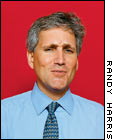NEW YORK (Money Magazine) -
You need only see titles like "Corporate Slim-Fast" or "Lies, Damn Lies," and "S&P Earnings" to know that reading Steve Galbraith's reports is a treat.
The real payoff, however, is that Galbraith, Institutional Investor's top-rated strategist, pairs a talent for a mean turn of phrase with the razor-sharp analytical skills he honed while at research shop Sanford C. Bernstein. These days, as Morgan Stanley's chief U.S. strategist, he's using that combination of wit and smarts to help guide the firm's clients through these uncertain times.
Q. Do you see any light at the end of the tunnel for stock investors?
| Wall Street's take on 2003
|

|
|
|
|
A. Earnings are going to be OK next year. You're going to get 12 percent earnings growth from the S&P 500.
Reason? First, returns have collapsed, so the bar is low. Second, capital is scarce, and that's forced companies to cut costs and restructure operations.
 |
|
| Steve Galbraith, chief U.S. strategist Morgan Stanley |
And finally, you have a lot of companies putting up disastrous results. In my perverse "reversion to the mean" mind, that's all good news. When a record number of companies lose money, they fire people, close plants, write off inventories.
That alone gives you some earnings growth and starts the earnings cycle once again. For example, Lucent's going to lose about $4 billion in 2002. If it loses only $1 billion in 2003, that's 50 [cents] a share in S&P earnings growth. It's still losing money -- just losing less.
Q. About one-third of all mutual fund assets are in money-market mutual funds. Why haven't investors moved back into stocks?
A. People are more optimistic than they were in 2001 that we're not headed for the Great Depression. But they're also less optimistic that investing in stocks is going to be fun anytime soon. Two years ago it was clear that you wanted to be in small-caps or value. None of that holds today. It's all kind of blah. The reason is that when you're going into and out of bubbles, all the old rules of thumb are off.
| 1-year return through Jan. 17. P/E based on estimate for next fiscal year. Growth from current estimate to next year's estimate. | | Source: Baseline |
|
Q. What will the economy look like over the next 12 months?
A. We expect 2.5 percent growth in gross domestic product. Not great but not a disaster. Bush's new economic team raises the odds that we'll see more fiscal stimulus and higher deficits, and both are appropriate given the weak economy. On the interest-rate front, I can't see the Federal Reserve lowering rates if the economy is recovering. If we start seeing a global recovery, I wouldn't be surprised to see some rebounding inflation. But it won't be an issue this year.
Q. What will be the big issues?
A. There are two. Do consumers collapse or do they weasel along? My bet is they weasel. That's a big deal because consumers have been singlehandedly holding up the economy. Second, will corporations start spending again? You've had a couple of years of massive retrenchment. In 2003 you'll see capital spending pick up as risk aversion abates.
Q. Which sectors will do well?
A. We still like health care. I'd avoid services companies, like hospitals and HMOs, and focus on biotech. It's just so damned hard to pick the one winner here, so call me a coward, but I'd stick to the Nasdaq Biotechnology iShares, an ETF [exchange-traded fund]. Within the pharmaceutical area, look for companies that have really lagged, like Wyeth, which trades at 17 times earnings and has a 2.4 percent yield.
Q. Defense stocks have moved up since the war on terrorism began. Are they still worth buying?
A. Yes, especially since they've pulled back recently. Defense is a long-term issue, since defense budgets keep going up. The best time to buy stocks like General Dynamics and Boeing is when everyone feels safe. Assume that you have a successful outcome in the Middle East and the stocks sell off. That's the time to buy. Likewise, sell when there's maximum fear.
Q. Your report pushing for the end of the double taxation of dividends got a lot of attention. Is investing in companies that pay high dividends a smart move to make now?
A. If taxes were eliminated, which I give a fifty-fifty chance, the knee-jerk reaction would be to buy regional Bells or utilities because they have high dividend yields. Instead, you should buy companies with very high cash flows that aren't paying a dividend today.
There's a whole corps of investors that won't buy Microsoft because it does not pay a dividend. [Microsoft on Jan. 16 announced its first-ever dividend.] Besides Microsoft, I would also consider high-cash-flow companies like Dell and Cisco Systems. If you start to pay a dividend, suddenly investors who like growth and income stocks will look at you.

|

